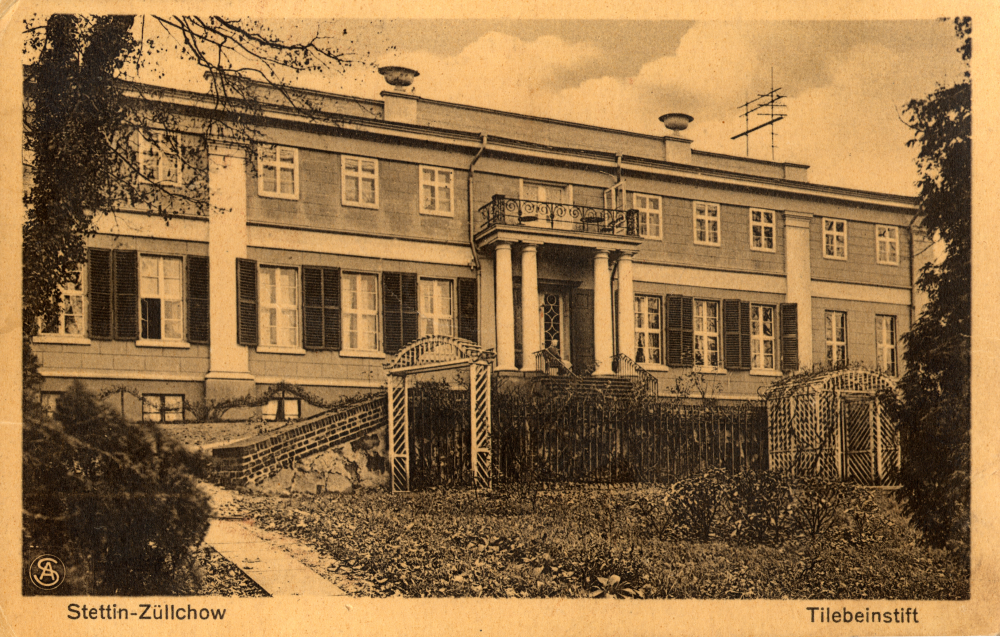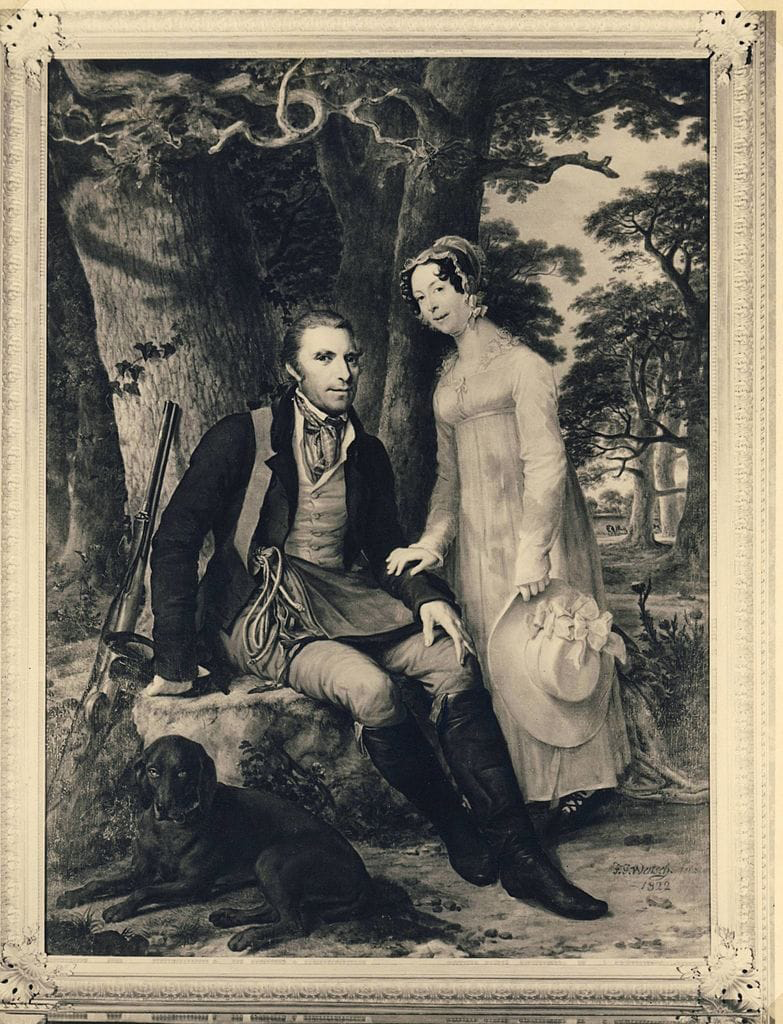Tilebein Park

Born on 20.12.1771 in Göttingen, she was an art patron organising many cultural events in Szczecin, a painter and founder of the art salon in Żelechowa. She is believed to have a great personality and was a widely respected person, who loved beauty and appreciated artists. She died on 21.08.1854 in Żelechowa at the age of 83.
Background and childhood
Sophie Auguste Caroline Tilebein was of French and English origin. Her great grandfather, Jacques Perard de Martignicourt was given knighthood from August III, king of Poland and Saxon. His son, Jacques de Perard, Sophie Auguste’s grandfather, was a preacher at the Evangelical Reformed Church in Gramzow (Uckermarck). In 1739, he moved to Szczecin, where he played an important role in the intellectual life of the city.
The mother of Sophie Auguste Caroline was Henriette Louise nee de Perard, who married Philip Henry Pepin in Hanover in 1769. In the same year, Philip Henry Pepin became a professor at the university in Göttingen. Mrs Pepin died in 1772, three weeks after giving birth to Sophie. Following his wife’s death, Philip succumbed to severe depression and Sophie was raised by her mother’s family. She was taught geography, botany, literature, harpsichord, singing and foreign languages. She came to Pomerania for the first time between 1786 and 1787 to visit her aunt, Sophie Dorothee Perard. Her aunt introduced her to the local society, who quickly became captivated by the wits and charm of the beautiful and talented 16-year-old Sophie.
Mrs Buyrette
In 1790, Sophie Auguste Caroline Pepin married a Szczecin-based merchant, Jean Rodolph Buyrette. He was a nature lover, so he took frequent trips outside the city with his young wife. It is likely that during one of their excursions they fell in love with the riverside hills at the Oder in Żelechowa and bought a small house for renovation there. Meanwhile, Mrs Buyrette held tea parties at their house in Szczecin at Gross Oderstrasse (Wielka Odrzańska), where she entertained her guests with playing music, singing and dancing. Her hospitality and social skills made her very popular and universally liked. Unfortunately, their happy marriage was shattered by the sudden death of Jean Rudolph in 1796. Her husband left no great inheritance with the most valuable thing being the estate in Żelechowa.
Mrs Tilebein
Less than a year after the death of her first husbandm, Sophie Auguste got married for the second time with Carl Gotthilfe Tilebein. After a modest wedding, the couple went on a 11-month honeymoon journey across Europe. They participated in cultural and social life of Berlin, Rotterdam and Paris and made new acquaintances (e.g. with Prince Louis Ferdinand von Hohenzollern). Mrs Tilebein mastered her harpsichord skills, literature and took classes in Italian, singing and guitar.
Having returned to Szczecin, Sophie took up housekeeping and established an art salon.
With the experience gathered during trips across Europe made Mr and Mrs Tilebein finally decided to remodel the estate in Żelechowa. Sophie was fascinated with the late-classicism architecture and the English landscape gardens. It is believed that the first plans for the building were drawn up by one of the greatest European architects, Carl Friedrich Schinkel, whom Mrs Tilebein met in 1806.
The construction took three years and the palace consisted of many rooms – apart from the bedroom, the master’s study, the mistress’ boudoir and guest rooms, the building housed a library, a dining room and a beautiful music room overlooking the park and the river. The interiors were decorated with bronze and silver candelabras, porcelain vases and numerous painting, including those painted by the talented Mrs Tilebein.
Music reigned supreme in the salon in Żelechów and Sophie Auguste herself often played the harpsichord. There were three grand pianos in the house together with a number of other musical instruments so that guests did not have to bring their own.
When Carl Loewe arrived in Szczecin, he quickly became one of the acquaintances of Mrs Tilebein, who took an interest in his works. The composer often played his own pieces at Sophie’s salon and dedicated them to his patron oftentimes.
The house was also visited by von Ingerslebens, Von Recks, family of Johann Wolfgang von Goethe, as well as Princess Elizabeth of Brunswick. Meanwhile, poet and philosopher Ludwig Giesebrech, Berlin playwright August Wilhelm Iffland and academics – Friedrich Calo and Justus Grossman – presented their works there.
Following her husband’s death in July 1820, Mrs Tilebein continued to run her art salon. She was a patron and a protector to many Szczecin-based artists.
Sophie Auguste Caroline Tilebein died childless on 21 August 1854 at the age of 83 and was buried beside her husband. Sophie directed in her will that some of the money be used for pensions for her friends and servants while the remaining funds together with the estate in Żelechów be donated to the Tilebein Stiftung Foundation running a boarding school for poor girls in distress.
The Foundation existed until 1945, however the air raid of the allied forces on Szczecin on 3 May 1944 destroyed the palace, the gardener’s house, the mausoleum and the nearby church, putting an end to the activities in Żelechowa. The retaining wall around the palace grounds at Robotnicza street and the currently neglected mansion park were the only structures to survive the war. In 1975, the foundation was renewed as the Tilebein-Stiftung Stettin-Züllchow with headquarters in Kiel.
Commemoration
Since 2018, the Żelechowa District Council and the participatory budget members have made several attempts to restore the park.
During a hike of the Szczecin Scenic Trail in May 2020, the hikers found 3 fragments of the commemoration plate which was secured on 5 September 2020 by the decision of the Municipal Conservation Officer from the National Museum at Mściwoja street in Szczecin. In the same month, dr Marek Łuczak together with the members of the Pomeranian History Society found the remaining fragments of the commemoration plate, two plates with the torches of the sarcophagi of Gotthilf and Sophie Tilebein, as well as the tomb of Gotthilf of 1821, which were also placed in the museum.
In 2023, on the initiative of the District Council, the Szczecin City Council passed a resolution, by which the area of the former park was officially named the “Tilebein Park” and a commemorative bench with a sculpture of Mrs Tilebein made by prof. dr hab. Marian Molenda was placed at the intersection of Dębogórska and Robotnicza streets.

